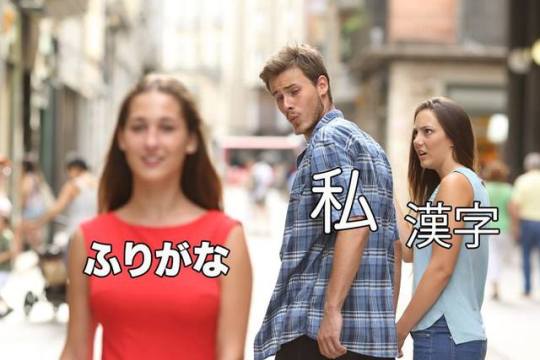Text
13) Compound Sentences [Part 2]
In the last post, we talked about a few of the many conjunctions that you can simply stick in between clauses in order to make compound sentences. Now let’s talk about the other way that you can make a compound sentence.
Here is your vocabulary:

【Changing the Verb】
Remember that there are 3 ways to end the comment section of a Japanese sentence:
with a verb
with an adjective
with a noun-copula bundle
It turns out that verbs, adjectives and the copula each have the power to act like a conjunction - you just have change their forms first. To keep things simple, in this post let’s just focus on how verbs can change into their conjunctive forms in order to make compound sentences. Every verb has 3 choices.
【The て Form】
The first choice is our old friend, the て form. Here is a quick chart showing you how to make the て form out of Godan, Ichidan and the 2 irregular verbs:

Notice that the て form doesn’t always end with て! The て form of (Godan) verbs that end in ぬ、む、ぶ and ぐ actually end with で. Don’t be alarmed, this is just a sound change.
Here are some examples:
① 【メガネをかけて】【本を読む】。
= glasses, put on and then book, read
= I put on my glasses and then I read a book.
② 【ケンタは一日を遊んで】【過ごしました】。
= as for Kenta, one day play, and then passed
= Kenta spent a whole day playing.
③ 【宿題をしな��て】【不合格しました】。
= didn’t do homework and so failed
= I didn’t do my homework and so I failed.
As you can see in example 3 the negative version of the て form operates in the same way as the positive version. The nuance is still “A and so B”, or “A and then B”, just in a negative way.
The basic idea is that when you change a verb into the て form, you are telling your listener or reader that you are not finished and that there is more information.* For this post, the idea is that using the て form allows you to attach another clause afterwards, making a compound sentence.
【まして】
The second way to turn a verb into its conjunctive form is with the まして ending. This ending is like a polite version of the て form. This ending is also in the same “family” of endings as ます、ません、ました、ませんでした and ましょう. More in the next section.
Here are some examples:
④ {ご迷惑をおかけしまして、}{申し訳ありません}。
= I have caused / will cause you trouble and so there is no excuse
= I’m very sorry to inconvenience you.
⑤{お返事が遅れまして、}{すみませんでした}
= reply was late and so I’m sorry
= I’m sorry that I was slow to respond to you.
【連用形】
Before we talk about the third and final way, there is a very useful Japanese grammatical term that I think you should know. The term is 連用形 (れん・よう・けい) and it means the conjunctive form. Verbs, adjectives and the copula all have 連用形 because they can all make way for another clause to be attached to them. Ok, but the question is - for verbs how do you make the 連用形?
The answer is that there are two versions. The 連用形 can be the stem + the polite form connector OR the stem + the て/た form connector! Here are the 連用形 for the verb 飲む as an example:

So you can see how this 連用形 is connected to what we have been talking about so far. The first version is what we need to attach まして (or if you needed the polite “family” of endings). The second version is what we need for the て form.
Well hold on because the 連用形 is important in one more way!
【The Third Form】
The third and final way that verbs can be used as a conjunction is by… using the 連用形 (the first version)!

Notice that Ichidan verbs and the 2 irregular verbs する and くる don’t need a connector. Their stems alone are enough. Here are some examples:
⑥ 【私は本を買い】、【妹は雑誌を買った】。
= as for me, book, buy and as for younger sister, magazine bought
= I bought a book and my little sister bought a magazine.
⑦ 【彼女は素敵なご飯を食べ】、【おまけに、新年の贈り物をもらいました】。
= as for her, wonderful meal eat and in addition, New Year’s present, received
= She ate a wonderful meal and in addition, received a New Year’s present.
It may feel incomplete in some way, but the 連用形 is perfectly grammatical when you want to make compound sentences.
【What Are the Differences Between the 3 ?】

So you have a sentence that ends in a verb and you want to make a compound sentence to sound more natural. What is the difference between the 3 different conjunctive forms!? I’m glad you asked.
まして is very simply the polite version of the て form. You hear this in set phrases like:
どういたしまして (you’re welcome)
はじめまして (nice to meet you)
あけましておめでとうございます (Happy New Year).
It sometimes also means that the speaker is going to leave off the second part of the sentence because the expectation is that you already know what they are going to say.
Be careful though. The まして ending is not used with ください, with requests or in casual speech. For that, you can just use the regular て form.
⑧ 私は本を買って妹は雑誌を買った。
⑨ 私は本を買い、妹は雑誌を買った。
Both of the examples above say “I bought a book and my little sister bought a magazine.” It’s also very easy to see where you could split these sentences in 2, but what is the difference between the two examples? Is there a different nuance?
Well there are 2 ways that they differ. It turns out that example 8 is much more likely to be spoken while example 9 is more literary. There is an idea that the て form gives speakers more time to think of what they will say next (It is true that you often hear a pause after the て form when people speak). On the other hand, since the 連用形 is mostly written, you wouldn’t need this extra time to think. Also you will sometimes see a comma after the 連用形 so that no one gets confused by the hiragana that comes at the end of it.
In terms of meaning and nuance, while the て form can mean either “A and then B” or “A and so B”, the 連用形 usually only means “A and then B”. In other words, it only tells us the order of the events, not that one lead to the other one happening.
【Conclusion】
So there you have it. A verb at the end of the comment section has 3 ways of allowing another clause to be attached to it. You can use the て form, or you can use the まして ending - both involve using the 連用形. The third way is simply the 連用形 itself, though this is usually in writing.
There is a very important thing to notice about all of the examples. The ending of the first clause does not tell you whether the sentence is past tense or not. You have to wait until the end of the second clause to find out the tense of the whole sentence! This is something that can be very difficult to get used to when you start learning Japanese. Don’t worry though, move at your own pace, ask lots of questions and you will improve. Don’t give up! See you next time.
Rice & Peace,
– AL (アル)
👋🏾
*Sentences sometimes end with the て form or with まして. This is actually a way to leave something unsaid, whether it be the speaker’s feelings, a request or a natural effect. For example はじめまして simply means “it is the first time meeting you”. The implied part is that this first time meeting was nice.
278 notes
·
View notes
Text
spooky japanese vocab 🎃

🎃 ハロウィーン ― halloween
🎃 南瓜 「かぼちゃ」 ― pumpkin
🎃 骸骨 「がいこつ」 ― skeleton
🎃 蝙蝠 「こうもり」 ― bat
🎃 蜘 「くも」 ― spider
🎃 黒猫 「くろねこ」 ― black cat
🎃 満月 「まんげつ」 ― full moon
🎃 ヴァンパイア ― vampire
🎃 吸血鬼 「きゅうけつき」 ― original japanese word for vampire
🎃 血を吸う 「ちをすう」― to suck blood
🎃 幽霊 「ゆうれい」 ― ghost
🎃 狼男 「おおかみおとき」 ― werewolf
🎃 透明人間 「とうめいにんげん」 ― invisible man
🎃 ミイラ ― mummy
🎃 フランケンシュタインの怪物 「フランケンシュタインのかいぶつ」 ― frankenstein’s monster
🎃 魔女 「まじょ」 ― witch
🎃 魔法使い 「まほうつかい」 ― wizard/sorcerer
🎃 魔法の呪文 「まほうのじゅもん」― a magic spell
🎃 魔法の呪文をかける 「まほうのじゅもんをかける」 ー to cast a magic spell
🎃 化け物 「ばけもの」 ― monster
🎃 鬼 「おに」 ― demon (traditional japanese)
🎃 悪魔 「あくま」 ― devil/demon
🎃 お化け屋敷 「おばけやしき」 ― haunted house
🎃 お化け話 「おばけばなし」 ― ghost stories
🎃 怖い 「こわい」 ― scary
🎃 恐ろしい 「おそろしい」 ― horrible
🎃 気味悪い 「きみわるい」 ― creepy/unpleasant
🎃 グロ ― grotesque
🎃 呪い 「のろい」― a curse
🎃 呪う 「のろう」― to curse s/o or s/t
ハッピーハロウィーン!💀 🎃 👻
3K notes
·
View notes
Text
Runic Languages And Symbols : Introduction
Runes are one of my favourite things to use in my craft. I like the look of them and how we can use them in our craft.
There are several different types of runes such as Theban script, Anglo Saxon runes, Enochian, Moon glyphs and Phoenician. I'll go into depth of each of them.
First Theban Script, it is known as the Wiccan alphabet. It is one of the main types of runes and is most commonly used in rituals and in book of shadows. It's quite simple to draw once you have the hang of it but might take some people more practice.
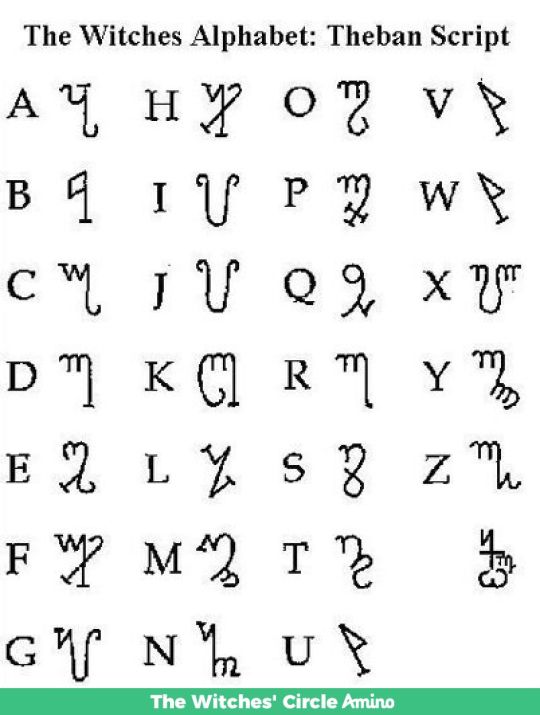
Second Anglo Saxon runes, this is an older type of rune. It is another main type of runes and is quite commonly used. As the name suggests it comes from Anglo Saxon times. The runes are easy to draw but the alphabet itself is harder to get. It is mostly use for rune stones and can be a great addition to your craft.

Third Enochian, some of you may recognise these runes. It is an angelic language and is commonly used in mediums.

Fourth Moon glyphs, these are a personal favourite because of how beautiful they are. Moon Glyphs are magick symbols used for connecting with nature and Esbat magick. Unlike the others they are usually used by drawing them with ink onto the skin. They are slight harder to draw because of this.
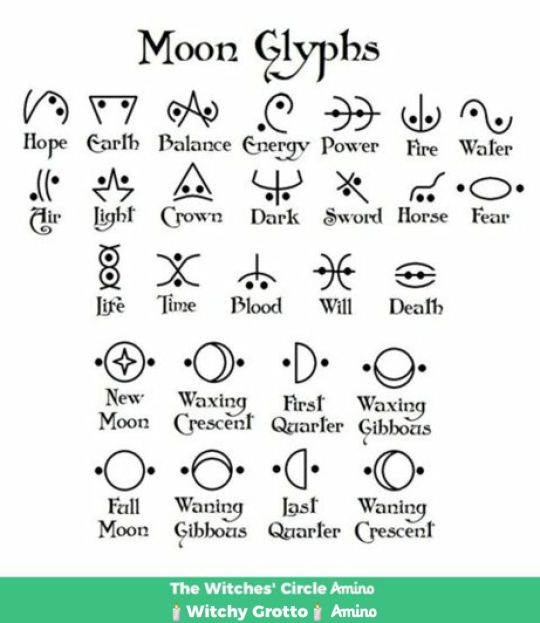
Finally Phoenician, Phoenician is the oldest recorded alphabet. It can be used for simply writing or for rituals.

Hope you found this helpful. Blessed be.
3K notes
·
View notes
Photo

1 Month 1 Language
1 Month Kanji Challenge
6 Words A Day
14 Day Langblr Challenge
30 Day Langblr Challenge
34 Hour Langblr Challenge
55 Days of Vocabulary Challenge
90 Day Vocab Challenge
100 Days Challenge For Langblrs
100 Hour 40 Day Language Challenge
Advanced Language Study
A Question A Day Challenge
BaBaDum Challenge
Build Your Vocab Challenge
Composition Challenge
Fiction Writing Challenge
Langblr 25 Challenge
Langblr Accent Tag
Langblr Culture Challenge
Learn A Language Challenge
Original Langblr Content Challenge
Review Challenge
Subtitles Challenge
Summer Language Challenge
Translating Challenge
Writing Challenge
Challenges for certain months:
February Polyglot Challenge
March Polyglot Challenge
April Polyglot Challenge
May Polyglot Challenge
May Polyglot Challenge
August Polyglot Challenge
September Polyglot Challenge
September: 30 Day Langblr Resource Photo Challenge
October Polyglot Challenge
November Polyglot Challenge
December Polyglot Challenge
December Polyglot Challenge
10 Polyglot Things to Do This September
10 Polyglot Things to Do This October
Langblr NaNoWriMo
9K notes
·
View notes
Note
Sorry if you’ve gotten this question before but what do you recommend for practicing writing characters? Like paper and pens? I’ve tried practicing on regular paper but I feel like it doesn’t help with getting the characters to look right and was wondering if there’s better ways to practice?
don’t worry! i haven’t gotten this exact question so it’s all good! also, writing characters is one of my favorite ways to learn them so i could answer questions about this all day
i do prefer practicing on paper with a pen (i say pen bc pencils usually smudge and just make things messy later on). i usually just grab whatever paper is nearby and use that, so most of the time it’s looseleaf.
if you’re worried about your characters looking right (by which i’m assuming you mean proportional and natural) then i do have a recommendation for you. you’ll need access to a printer though for this one.
in a recent ask i mention hanzi grids as a way to practice writing characters, so i’m going to bring that recommendation back and add on to it a little bit.
once you make your free account (you really just need an email address to do this) and go to make your grids, here’s what i recommend you do.
at the top of the page there will be a box labeled “content” that will look like this:

as you can see i have the phrase “你好嗎” typed into the box with the option “single characters selected” on the drop down menu. what you would do is type or paste the words you want to practice into this box.
next you should go to the sidebar and look at these options:

“visible characters” makes the grids look like this:

“opacity” just toggles how dark the gray is for the lighter characters. you can also toggle the “visible characters” option to show less of the characters so you can practice on your own so it would look something like this:

once you’ve set the grids up to your liking, you just hit the button that says “generate pdf” and then print it. once you’ve got that, just practice writing until you’re satisfied!
i really hope this was what you were looking for! 加油!
2K notes
·
View notes
Photo
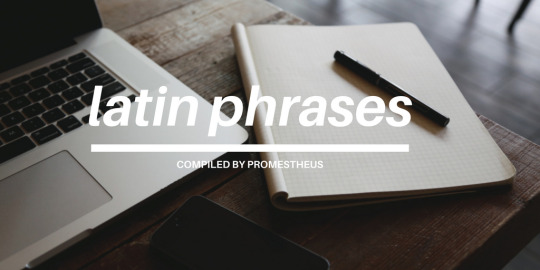
just a lil list of motivational phrases that’ll hopefully inspire you in some way ✨ (source)
“ipsa scientia potestas est” - knowledge itself is power
“dimidium facti qui coepit habet” - he who has begun has the work half done (Horace)
“ad altiora tendo” - i strive towards higher things
“vita mutatur, non tollitur” - life is changed, not taken away
“vincit qui se vincit” - he/she conquers who conquers himself/herself
“sic parvis magna” - greatness from small beginnings
“vincit qui patitur” - he conquers who endures
“tuum est” - it’s up to you
“tempora mutantur et nos mutamur in illis” - the times are changing, and we change in them
“astra inclinant, sed non obligant” - the stars incline us, they do not bind us
“dum spiro, spero” - while i breathe, i hope
10K notes
·
View notes
Text
lots of little latin locution
a deo et rege - for god and king
a deo lux nostra - our light comes from god
absque labore nihil - nothing without hard work
amicis semper fidelis - always faithful to friends
audaces fortuna juvat - fortune favours the bold
carpe diem - seize the day
deus fortitudo mea - god is my strength
cherche et tu trouveras - seek and you will find
celer et audax - swift and bold
dulcius ex asperis - sweeter after difficulties
dum spiro spero - whilst i breathe, i hope
esse quam videra - to be, rather than to seem
facta non verba - deeds, not words
fides et justitia - faith and justice
fulminis instar - like lightning
in scentia veritas…. - in science truth
… in arte honestas - in art honour
in veritate victoria - victory in truth
magnum in parvo - much in little
memor esto - remember your ancestors
ne quid falsi - nothing false
nec elatus nec dejectus - never overjoyed nor dejected
nunquam non paratus - never unprepared
perge sed caute - advance but cautiously
pro rege et patria - for king and country
semper praecinctus - ever ready
studio sapientia crescit - wisdom grows by study
8K notes
·
View notes
Photo


Here’s the next lot of The 100 Kanji Challenge!
Vocabulary:
Tuesday 火曜日 (か・よう・び)
Volcano 火山 (か・ざん)
Fire (accident) 火事 (か・じ)
Wednesday 水曜日 (すい・よう・び)
Money お金 (お・がわ)
Friday 金曜日 (きん・よう・び)
Saturday 土曜日 (ど・よう・び)
She/her 彼女 (かの・じょ)
Girl 女の子 (おんな・の・こ)
Woman 女の人 (おんな・の・ひと)
Student 学生 (がく・せい)
University 大学 (だい・がく)
School 学校 (がっ・こう)
To Live 生きる (い・きる)
Teacher 先生 (せん・せい)
Last Month 先月 (せん・げつ)
267 notes
·
View notes
Text


FIRST SET OF KANJI FOR THE 100 KANJI CHALLENGE!
Click here for more detailed stroke order.
Vocabulary:
Sunday 日曜日 (にち・よう・び)
Japan 日本 (に・ほん)
Monday 月曜日 (げつ・よう・び)
January 1月 (いち・げつ)
Thursday 木曜日 (もく・よう・び)
Mt. Fuji 富士山 (ふ・じ・さん)
Volcano 火山(か・ざん)
Stream, Brook 小川 (お・がわ)
Japanese Person 日本人 (に・ほん・じん)
Entrance 入口 (いり・ぐち)
Exit 出口 (で・ぐち)
Population 人口 (じん・こう)
Train 電車 (でん・しゃ)
Automobile 自動車 (じ・どう・しゃ)
Speciality 専門 (せん・もん)
511 notes
·
View notes
Text
Hiragana and Katakana tips for Beginners
A little snapshot of my own hiragana and katakana characters.

Many beginners encounter problems while learning Japanese writing systems: hiragana and katakana. I decided to take a look at the most common, in my opinion, mistakes made by learners.
Remember, the stroke order isn’t there to make your life harder (although it does most of the time). It is really important to write the characters the certain way as any other way makes them look slightly or completely different.
Before I begin I would like to explain the particular way I write き・さ・ふ・そ.
There are, as far as I know, two different ways to write a character. The way I write them is more of a caligraphic approach (the second line). Mostly, learners tend to choose the first approach.
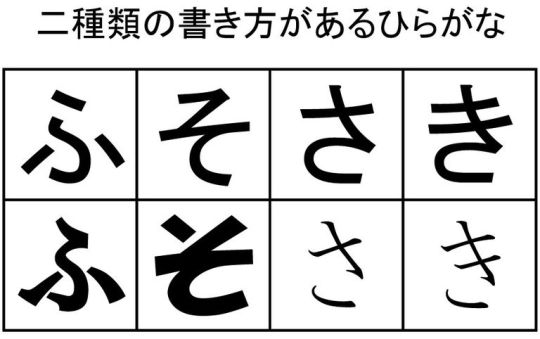
I switched the way to write this characters as ふ is faster to write (three strokes instead of four). そ・さ・き plainly look better to me.
Getting to the gist of the post now - common mistakes made by beginners.
1. Mirroring
Even though hiragana is more complicated (more strokes and more curvy ones), the characters are fairly more distinguishable. Learners might however make mistakes by mirroring the characters (き・ち・さ・く are the trickiest ones among them).
2. Confusing hiragana り and katakana リ

The hiragana ri り is shown at the left side. The first stroke should go down and then a little up (shown at the bottom). Because of this ri り could be written in hiragana as the 2nd and 3rd example on the left side show.
The katakana ri リ however doesn’t have a pointed end in the first stroke (as shown on the right).
While writing a word in hiragana or katakana, you must make sure you write the correct ‘ri’. You musn’t write a word in one system and the throw a character from the other system!
e.g. Writing リんご ( リんご ) instead of りんご
3. Mixing up similar characters
I think this mistake applies more to katakana. The most common mistake is writting shi シ insted of tsu ツ and n ン instead of so ソ.
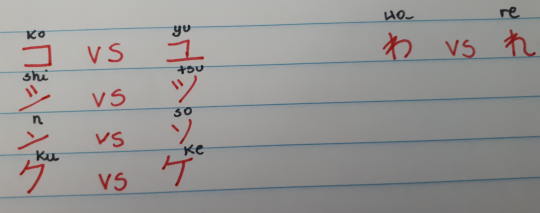
Confusing so ソ and n ン
You should start by writing the small line first. Then the longer one. The longer line in so ソ should be pointing high, while the one in ン should be lower.
Many Japanese people tend to make n ン really flat and so ソ higher (like me in the first picture).
Notice that the longer line is written from different sides!

Confusing shi シ and tsu ツ
The same goes for this characters. Shi シ is n ン with two small lines, while tsuツ is so ソ with two small lines.

Confusing ko コ (the first one) and ユ (the second one)
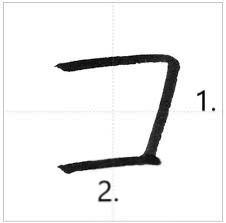
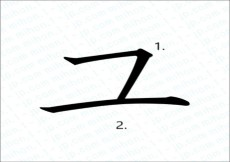
Ko コ and yu ユ have similar writing patterns. The last stroke in yu ユ should be long and going past the first one.
Confusing ku ク(the first one) and ke ケ (the second one)

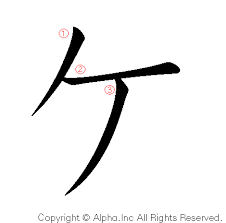
Ku ク consists of two strokes, while ke ケ of three. The first and second line in ke ケ aren’t connected with their ends. The same goes for the second and third line.
Confusing wa わ and re れ (and ne ね)
Easily mistaken characters in hiragana.
From left to right: ne, re, wa

Plainly, wa わ should have a round stroke (like a belly) and re れ a little pointed end (like a leg). Ne ね has a little circle inside.
Notice that all three of them consist only of two strokes!
4. Ro ロ and its stroke order
Ro ロ has the same stroke order as the kanji for mouth 口. Don’t write it like a plain square. It has three strokes, not four! It looks different than normal when written using four or even two strokes.
Notice that the kanji looks bigger than ro ロ in normal digital font.
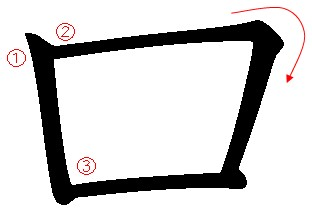
Hope I cleared up some things for you. If you have some questions regarding Japanese writing feel free to ask me!
以上。
2K notes
·
View notes
Text
Satori Reader ~ A new project by the team that brought us Human Japanese (°◡°♡)

Morning fam! Because I am a huge throbbing nerd for the Human Japanese series and use it every other day for routine study, their latest project - Satori Reader - was brought to my immediate attention.
Screenshots have been taken of the website’s free content to give you a peek into what is on offer. I’m giving it a trial run for the moment, but my fingers are itching to subscribe - something I can do at any point with relative ease.

For anyone who is floundering in the grey waters of intermediate study, and especially for those whose study is self perpetuated, there’s a good chance you’re looking for some sort of landmark in that churning mess to orient yourself by. A metaphorical island, with sparkling shoreline, verdant forest, and plentiful resources to help you grow and flourish.
I’m talking content. As many bloggers have mentioned, there is a plethora of material out there to help us learn the framework and mechanics of 日本語. It’s not at all difficult to source grammar lessons, vocabulary lists, kanji writing schematics, charts and even entire textbooks - and for that we are eternally thankful. However, the intermediate learner sitting at their own dining room table with an open laptop, a cup of tea, the latest anime OST on repeat and a Japanese novel in their quivering hands is leafing through the pages and quietly mouthing how in the everliving f**k…
This is where SR gently takes your hand and says, here’s how, you foulmouthed otaku.

This is an excerpt from a level 3 difficulty article about Kona the cat (可愛いね)
Like every other article available on the website, it is voiced over by a native speaker, clearly and naturally - with all the intonation you would expect to hear in conversation *heavy breathing* Not only that, but as the audio plays, the corresponding Japanese text is underlined in blue to show where in the text they are reading from. This means that if you are proficient enough, you can follow along at pace.
Too slow? They got you fam! Individual lines of text are divided into sound bytes, meaning you can take this task one sentence at a time.
Individual kanji, jukugo (several kanji that make up one word) and particles within the text can also be clicked to reveal a Human Japanese style dictionary entry. Words you’d like to revisit can be added to your studylist.

The symbol marking the end of each sentence, when clicked, offers you an english transliteration, which I advise you utilise with a degree of self control. Try to hold off clicking it until you’ve really given the sentence a go - clicking on kanji you don’t recognise and piecing all the information together in order to get an idea of what’s being said. Then, when you finally check the translation, your hard work might be rewarded with a confirmation that you indeed read correctly. Which, by psychology standards, is a healthy and affirming process. We are hardwired for rewards my dudes!
I could go into detail about the many little features that make this web project so well thought out and considerate of our individual study methods and goals, but I’ll leave that to you to explore and find out. For me at least, the true worth of SR lies mainly in the reading content and the empathetic format it’s presented in.
The way it Aladdin style reaches out, offering us a whole new world.
Give the free subscription a whirl! If you like it, consider a paid subscription. This directly funds future content which directly benefits you!
~ Thanks Human Japanese team ~
Update (╯✧▽✧)╯
After giving SR a good go and fully testing its arsenal of functions, I realised my initial review bordered on plain lazy. This update is going to give you warm prickles because it turns out that one of the features included in the Review section of SR is an integrated flash card program with full Anki support *prayer hands emoji*

This means that whatever vocabulary you add to your studylist automatically generates a flashcard that you can either review within the SR website, or via your Anki software. Here’s an example:

Straight away, SR gives you an edge in your revision by implementing context. In fact, as well as offering you the sentence you saved the word from, it offers you a link to the entire article it was taken from (see: REVEAL IN FULL ORIGINAL CONTEXT)
This is incredibly helpful, as dictionary entries for any word or phrase you select often include a specific explanation about how that word is being used within the context of the sentence or how it is being used by the narrator to portray his or her story.

I hope that this extra glimpse into the Review section of Satori Reader gives you an idea of how incredible a resource this is.
Go ahead and enjoy the unique pleasurable pain that is reading and comprehending 日本語!!
4K notes
·
View notes
Photo
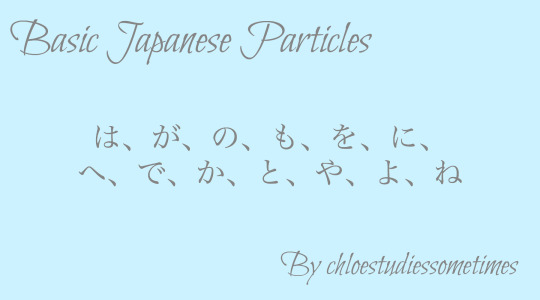
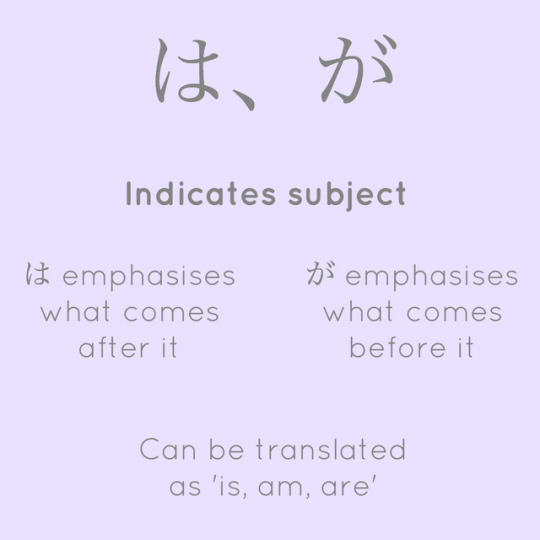

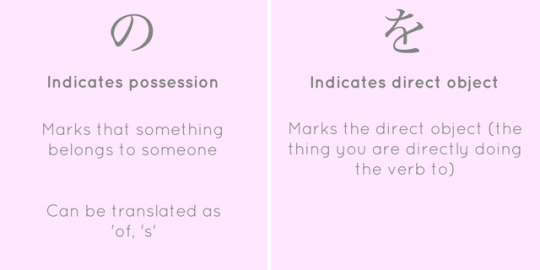
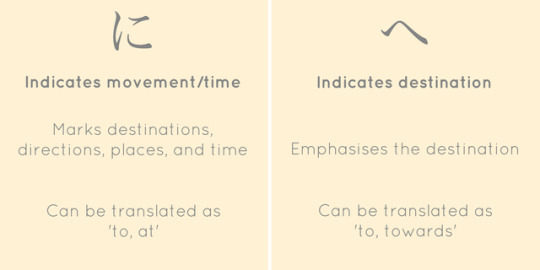
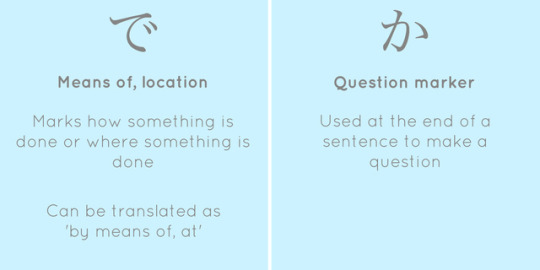

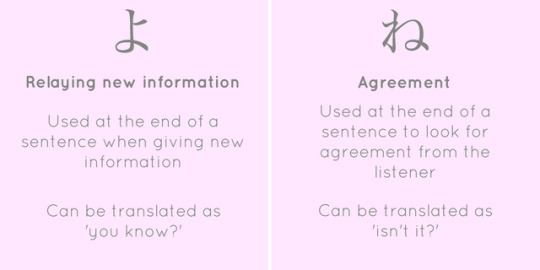
I’ve been meaning to make this post for a while, and I got an anon the other day asking about particles and a request from someone to make this post, so here it is! A list of basic particles and their usage! I hope this can help anyone struggling with particles and how to use them, but if I have made any mistakes please let me know ^^ (also please don’t remove my caption!)
15K notes
·
View notes
Photo

Hello hello language learning friends, I’ve added a pack of 8 productivity pages so you can organise your studies and reach your language learning goals! ✨
Includes goal planner, 100 days of productivity, study checklist, lesson summaries and more! It’s also available in 6 colours, all included in the download!! Head over to my shop to see the full list of pages included and colours available! ✨
118 notes
·
View notes
Text
2019年7月10日 12時03分
08日/30日.
08. Record yourself talking in Japanese. Listen to it and make notes on your pronounciation.
DUDES, I FOUND THIS AWESOME JAPANESE POEM FOR PRONOUNCIATION PRACTICE!
It really works out your mouth, I totally recommend it if you want to improve your pronounciation! i’m going to try to do this daily. There’s a slow & fast version in the video below!https://m.youtube.com/watch?v=W_JcI0kkjgo
Amenbo no Uta - Hakushuu Kitahara
Romaji:
amenbo akaina a i u e o
ukimo ni koebi mo oyoideru
kaki no ki kuri no ki ka ki ku ke ko
kitsutsuki kotsu kotsu karekeyaki
sasage ni su wo kake sa shi su se so
sono uo asase de sashimashita
tachimasho rappade ta chi tsu te to
tote tote tatta to tobitatta
namekuji noro noro na ni nu ne no
nando ni numette nani nebaru
hato poppo horo horo ha hi hu he ho
hinata no oheya nya fue wo fuku
maimai nejimaki ma mi mu me mo
ume no mi ochitemo mi mo shimai
yakiguri yudeguri ya i yu e yo
yamada ni hi no tsuku yoi no ie
raichou wa samukaro ra ri ru re ro
renge ga saitara ruri no tori
wai wai wasshoi wa i u e wo
uekiya idogae omatsuri da
ひらがな:
あめんぼあかいなあいうえお
うきもにこえびもおよいでる
かきのきくりのきかきくけこ
きつつきこつこつかれけやき
ささげにすをかけさしすせそ
そのうおあさせでさしました
たちましょらっぱでたちつてと
とてとてたったととびたった
なめくじのろのろなにぬねの
なんどにぬめってなにねばる
はとぽっぽほろほろはひふへほ
ひなたのおへやにゃふえをふく
まいまいねじまきまみむめも
うめのみおちてもみもしまい
やきぐりゆでぐりやいゆえよ
やまだにひのつくよいのいえ
らいちょうはさむかろらりるれろ
れんげがさいたらるりのとり
わいわいわっしょいわいうえを
うえきやいどがえおまつりだ
i messed up so many times, but had so much fun!
-i.
889 notes
·
View notes
Text

一意専心, ichi i sen shin
Devoted, wholeheartedly, with one’s heart and soul
123 notes
·
View notes
Text
Day 1: Trip of a Lifetime JAPAN!
Alright, so hello hello first post on here but welcome! So day 1 of my trip to Japan. Getting to the airport of fun XD the rain was a nice bath for my car. Made it though in one piece and got to my gate.
Now before I made myself comfortable at my gate I had to go though TSA. I have type one diabetes and wear a medtronic 670g with the sensor. When I got to the bents where you empty your stuff in bins all I did was inform them that I had an insulin pump and would like a pat down. Boom. Done. They quickly got me 2 female officers and did the pat down. Super nice people! Now I wait here at my gate. I catch a flight from Utah to L.A then to Japan. Updates to follow!
0 notes
